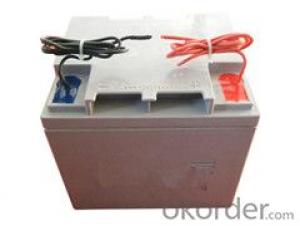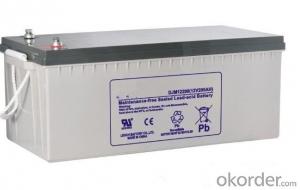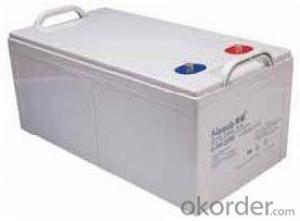Gel Battery MPG Series Battery MPG12V125F
- Loading Port:
- Shanghai
- Payment Terms:
- TT OR LC
- Min Order Qty:
- 1000 unit
- Supply Capability:
- 500000 unit/month
OKorder Service Pledge
OKorder Financial Service
You Might Also Like
Range summary:
The MPG range gel batteries are designed with front terminal structure. The perfect design ensures MPG series battery the high reliability and makes the installation quite simple and safe when placed on a standard relay rack tray or in a closed cabinet. Adopt Flat plates with gel electrolyte.
This new technology leverages on the advantages of the AGM and Ares technology to provide better cycle performance versus the AGM technology and a shorter time discharge performance as compared with the Gel technology.
MPG range gel battery is designed with high energy density and suitable for 19", 23" rack or cabinet, and also offers options of top connection and side of monoblocs connection. MPG range battery can be equipped with central gas collection system according to the requirement of customer.
The MPG batteries are ensured the quality with the ISO9001 standard.

Technical feature:
Gel technology applied in MPG range batteries.
Front-access terminal connections for fast and easy installation and maintenance
Suitable for 19", 23" rack or cabinet
Excellent special lead-tin-calcium formula alloy for Grids and plates
Mircoporous glass mats in low resistance as separator
Self-regulating pressure relief valve
12+ years expectant Life under full float service at 25oC(77oF)
Type: | MPG12V125F | |
Voltage: | 12V | |
Nominal Capacity: | 125Ah(C10) | 125Ah(10 hours rate:) |
Length: | 558mm | |
Width: | 125mm | |
Height: | 270mm | |
Height with termial: | 270mm | |
Weight: | 48Kg |
Compliant standards :
IEC60896-21/22
Din standard
UL
Manufactured under system ISO9001(TUV)
Battery installation compliant with:
EN 50272-2 or local equivalents
Main application:
Telecommunications
Uninterruptible power supply (UPS)
Switchgear / utility
Other applications to provide integrated stored energy system
Products characteristics:
Recommended float charge voltage for 12V battery:
2.25Vpc at 25oC(77oF)
Self discharge rate: < 2% per month at 25oC(77oF)
Shelf life: six months at 25oC(77oF)
Valve regulated system, no water addition needed.
FAQ
![]() What is sulfation of batteries?
What is sulfation of batteries?
Sulfation is the formation or deposit of lead sulfate on the surface and in the pores of the active material of the batteries' lead plates. If the sulfation becomes excessive and forms large crystals on the plates, the battery will not operate efficiently and may not work at all. Common causes of battery sulfation are standing a long time in a discharged condition, operating at excessive temperatures, and prolonged under or over charging.
![]() How long a battery can last?
How long a battery can last?
The service design life of a battery are vary considerably with how it is used, how it is maintained and charged, temperature, and other factors.
![]() Do batteries self-discharge when not in use?
Do batteries self-discharge when not in use?
All batteries, regardless of their chemistry, self-discharge. The rate of self-discharge depends both on the type of battery and the storage temperature the batteries are exposed to. However, for a good estimate, Narada batteries self-discharge approximately 4% per week at 80ĄăF.
![]() How can I evaluate the health and charge state of a battery?
How can I evaluate the health and charge state of a battery?
Routine battery examinations divulge irregularities in the charging system as well as in the batteries. The principle method is to examine the electrochemistry of the battery through hydrometric electrolyte inspection. As previously discussed, this important examination cannot be accomplished with sealed absorption or gel batteries. Voltage readings alone require experience to interpret. Hydrometric readings will uncover early warnings of overcharging or overdischarging before batteries are damaged. The state-of-charge and reliability of a lead acid battery can best be determined by the specific gravity of the electrolyte measured directly with a common bulb-type hydrometer with a glass float. We do not recommend the ball float type hydrometer. Specific gravity is a unit of measurement for determining the sulfuric acid content of the electrolyte. The recommended fully charged specific gravity of marine batteries is 1.255 to 1.265 taken at 80ĄăC More than .025 spread in readings between fully charged cells indicates that the battery may need an equalization charge. If this condition persists, the cell is failing and the battery should be replaced. Since water has a value of 1.000, electrolyte with a specific gravity of 1.260 means it is 1.260 times heavier than pure water while pure concentrated sulfuric acid has a specific gravity of 1.835.
- Q: How to repair the battery?
- Charge the battery at constant voltage. It is the beginning of the time, using 0.1C ~ 0.25C current charge, to 16.2V later, by reducing the current method to maintain the charging voltage, until the charge current drops to 0.03C when the stop charging.
- Q: How is the capacity of the battery defined?
- General circuit has a battery protection circuit, once the battery voltage is less than 10.8V will automatically cut off the electricity to prevent the battery because of over-discharge and damage. (Nominal value of 12V battery internal six cell grid) with the battery discharge current multiplied by the discharge time to express how much energy the battery can store, is a very image of a measure. The greater the value of the battery, indicating that the battery can store more energy. But does not mean that the battery can use such a large current discharge.
- Q: What are the technical parameters of the battery?
- Usually the capacity of the power supply is expressed by kV · A or kW. However, as a power supply VRLA battery, the use of security (A · h) that its capacity is more accurate.
- Q: What battery does the van use?
- The most obvious feature of lead-acid batteries is the top of the plastic cover can be unscrewed, there are ventilation holes above. These fillers are used to fill pure water, check the electrolyte and the use of exhaust gas. In theory, lead-acid batteries need to check the density of each electrolyte and the level of liquid, if there is a need to add distilled water. But with the upgrading of battery manufacturing technology, lead-acid battery development for the lead-acid maintenance-free batteries and colloidal maintenance-free batteries, lead-acid batteries do not need to add electrolyte or distilled water. Mainly the use of positive electrode to produce oxygen can be absorbed in the negative oxygen cycle, to prevent water reduction. Lead-acid water batteries are mostly used in tractors, tricycles, car start, etc., and maintenance-free lead-acid battery wider range of applications, including uninterruptible power supply, electric vehicle power, electric bicycle batteries. Lead-acid batteries according to the application needs to be divided into constant current discharge (such as uninterruptible power supply) and instantaneous discharge (such as car to start the battery).
- Q: 80ah how much battery storage capacity?
- 0AH storage is 80AH ah If the actual storage capacity will have to see the brand. I have seen 100AH only 24 pound. This is not even 60AH.
- Q: How does the battery increase the voltage?
- You can use the same battery in series, with 5 12v battery in series becomes 60v, if you need the current is relatively small, you can use DC-DC module to 12v voltage rise to 60v.
- Q: What is a maintenanceable battery?
- Maintenance-free battery due to its own structure on the advantages of electrolyte consumption is very small, in the life of the basic need not add distilled water.
- Q: Battery 200ah / 104 what does that mean?
- Lead-acid battery nominal voltage is 2V / (each or monomer), but in fact will be higher than 2V, so the actual use and charging equipment for the matching will use 104, also useful 103, also useful 108 Only.
- Q: How does battery activation work?
- Always keep the battery surface clean. Found that the surface of dust and acid, it should be timely wipe, wipe can be wiped with soda water wipes wipe again, after rinse with water.
- Q: Lead-acid battery how to maintain?
- After passing the test, cover the exhaust cutting, pay attention to restore the filler, cover the battery cover, if the cover is glued, then glue bonding.
Send your message to us
Gel Battery MPG Series Battery MPG12V125F
- Loading Port:
- Shanghai
- Payment Terms:
- TT OR LC
- Min Order Qty:
- 1000 unit
- Supply Capability:
- 500000 unit/month
OKorder Service Pledge
OKorder Financial Service
Similar products
Hot products
Hot Searches
Related keywords





















